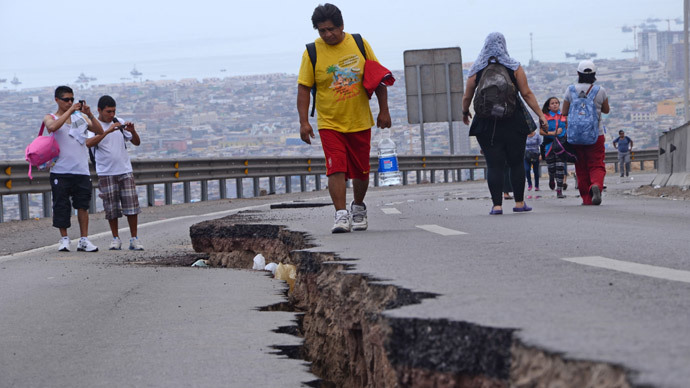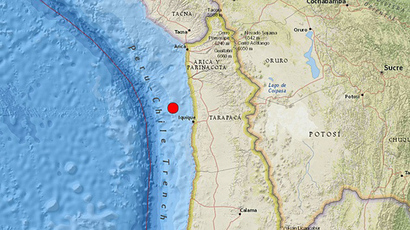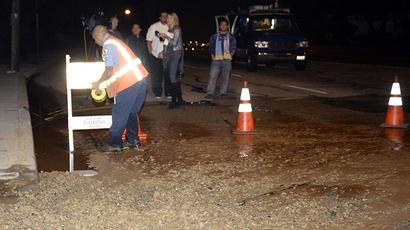'Ring of Fire' fears renewed following earthquakes in California, Chile and Panama

A rash of earthquakes within the last week along a section of the Earth infamous for seismic activity is causing concern that more tremors will soon occur near the ominously named “Ring of Fire.”
Experts don’t think that a series of quakes in recent days are related to one another, but all seem to agree that three major incidents in both North and South America share at least one common bond: each quake and their subsequent aftershocks were located along the circum-Pacific seismic belt, or “Ring of Fire,” where scientists with the United States Geological Survey say 90 percent of the world’s earthquakes occur.
The magnitude-5.1 quake near Los Angeles, California last Friday may be thousands of miles away from the epicenters in Chile and Panama associated with the events on Tuesday and Wednesday this week, but their positions on the Ring of Fire put them into an a special category of quakes that include the one that shook Japan in 2011 and caused the major tsunami that contributed to the meltdown at the nuclear plant in Fukushima responsible for roughly 16,000 deaths. Around 81 of the world’s largest earthquakes, the USGS says, occur along the Ring of Fire.
According to seismologists, the Chile quake occurred because of activity involving two major tectonic plates that share a roughly 7,000-mile-long boundary beneath the eastern Pacific Ocean and are considered part of the Ring of Fire. The USGS says that that quake was caused when the massive Nazca plate slipped eastward underneath the continental crust of South America.
“The Nazca plate is sliding underneath the South American one at an average rate that ranges from three inches a year along its southern half to 2.6 inches a year along its northern extent,” Pete Spotts wrote for the Christian Science Monitor this week.
But seismologists say that recent activity within this region won’t necessarily nudge other tectonic plates into pushing the earth around further. Aftershocks, however, may continue to be a cause for concern within the area for upwards of weeks.
Speaking to ABC News this week shortly after a quake in Chile on Tuesday occurred and caused no fewer than six deaths, California Institute of Technology staff seismologist Kate Hutton said the possibility of severe aftershocks should remain something that residents there consider in the coming days.
“The biggest risk is aftershocks for the 8.2 in the same area where the 8.2 occurred. They’ll become less frequent with time, but the risk still exists for days and weeks,” Hutton said of the Chilean disaster.
Tuesday’s quake in Chile prompted authorities to evacuate over 900,000 people, RT reportedearlier this week, and the toll of damages is still being assessed by officials.
Just one day later after that 8.2-magnitude earthquake brought panic to Chile and Latin America’s Pacific Coast, a 6.2-magnitude tremor centered nearby outside of David, Panama plagued the people there further, Reuters reported.
Even still, seismologists say these quakes aren’t related to the one that occurred outside of LA last week, but are rather random episodes located along the same so-called Ring of Fire.
“The odds are overwhelming that they're not related," John Vidale, a seismologist with the University of Washington-Seattle, told USA Today this week of the quakes in both Chile and Panama.
"There's no way that last month's Los Angeles quakes were related" to the ones this week in Central and South America, he added.
Robert Muir-Wood, a scientist with the RMS catastrophe modeling firm, told Doyle Rice at USA Today that "There is no evidence of linkages in activity between different regions around the Ring of Fire.”
"This earthquake is of a size that happens somewhere about once a year," Muir-Wood said. "The location is no particular surprise - the Chile subduction zone is the world's most active, and northern Chile has not seen really big subduction zone earthquakes for some decades, unlike southern Chile."
"Most quakes have about a 5 percent chance of being followed by a bigger quake, most of the time just a little bigger," Vidale added to the paper.
And although the Chilean quake has so far caused six deaths, experts say it could only be a sampling of what’s to come. Cornell University geophysicist Rick Allmendinger told the Christian Science Monitor that Tuesday’s quake was actually preceded by a magniturde-6.7 tremor two weeks earlier.
Indeed, "one of the possible scenarios that we're monitoring right now is that it is still possible that the earthquake we had last night is actually a foreshock to a much bigger earthquake," he told the paper. "For the sake of our Chilean friends, we hope that it doesn't happen."














